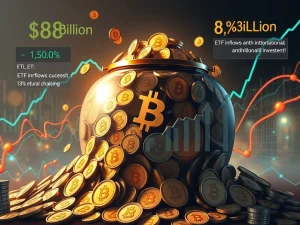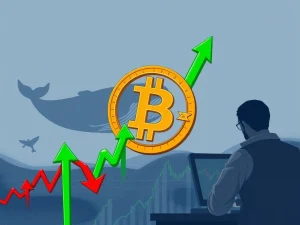Bitcoin’s Spectacular Surge to $85.8K: Are Bulls Really Back in Control?

Cryptocurrency enthusiasts, brace yourselves! Just when market pessimism seemed to grip the Bitcoin sphere, a spectacular surge has occurred. Bitcoin (BTC) has defied recent downtrends, staging an impressive rally to reclaim the $85,800 mark. This unexpected price action has sparked a crucial question: Are the Bitcoin bulls truly back in charge, or is this merely a fleeting moment of optimism in a sea of uncertainty?
Bitcoin’s Rally: A Glimpse of Bullish Momentum or a False Dawn?
The week commenced on a high note for Bitcoin, breaking through the $84,500 barrier on April 14. Initial optimism seemed to stem from news regarding potential tariff relief announced by US President Donald Trump. However, this excitement proved short-lived. Traders quickly grew cautious as it became clear that any relaxation in tariffs was temporary and the threat of renewed tariffs on the electronics supply chain loomed large. This uncertainty, stemming from ongoing US-China trade tensions, injected a dose of reality into the Bitcoin market, curbing newfound confidence. This explains why Bitcoin struggled to breach the $86,000 ceiling and why derivatives markets indicated limited short-term bullish potential. Let’s delve deeper into the factors influencing this cautious sentiment.
Futures Market Signals: Are Traders Really Convinced?
Analyzing Bitcoin futures contracts provides valuable insights into trader sentiment. A key indicator is the annualized premium on monthly futures contracts. Let’s break down what this means:
- Premium Peak: On April 11, the premium reached a peak of 6.5%.
- Subsequent Drop: This premium has since declined to 5%.
- Neutral to Bearish Threshold: A 5% premium is considered near the neutral to bearish zone.
- Seller Expectations: Typically, sellers demand a 5% to 10% annualized premium for longer settlement periods.
- Reduced Leveraged Buying Interest: A premium below this range suggests diminished enthusiasm from leveraged buyers.
This data suggests that while there was initial bullishness, it has waned, indicating that futures traders are not fully convinced of a sustained upward trend.
Stock Market Ties: Damping Bullish Momentum?
The brief surge in trader excitement can be traced back to President Trump’s April 13 announcement about reviewing semiconductor tariffs. The market interpreted this as potential exemptions for smartphones and computers, as reported by Yahoo Finance. However, Trump’s statement, “We want to make our chips and semiconductors and other things in our country,” injected uncertainty. This period of fluctuating expectations triggered emotional swings among Bitcoin traders.
Interestingly, the performance of broader markets, particularly technology stocks heavily reliant on global trade, appears to be influencing Bitcoin sentiment. The intraday correlation between Bitcoin and the stock market, particularly the S&P 500, has strengthened. This correlation seems to be dampening bullish enthusiasm. The question remains: is this influence limited to BTC futures, or does it extend further?
S&P 500 futures (left) vs. Bitcoin/USD (right). Source: TradingView / Crypto News Insights
Options Market Insights: Gauging Professional Trader Sentiment
To discern whether Bitcoin trader sentiment is merely mirroring S&P 500 trends, examining BTC options markets is crucial. The 25% delta skew indicator is a valuable tool for this. Here’s how to interpret it:
- Delta Skew Explained: This indicator measures the difference in implied volatility between put (sell) options and call (buy) options.
- Anticipating Price Drops: If professional traders anticipate a significant price decline, the 25% delta skew rises above 6%. This is because put options (betting on a price decrease) become more expensive than call options (betting on a price increase).
- Brief Optimism: On April 13, the Bitcoin options delta skew briefly dipped below 0%, signaling mild optimism.
- Momentum Fades: However, this positive momentum did not persist on April 14.
- Confirmation from Futures: This reinforces the data from Bitcoin futures, indicating a lack of strong bullish sentiment despite the price recovery from $74,440 lows.
Bitcoin 30-day options 25% delta skew (put-call) at Deribit. Source: Laevitas.ch
Stablecoin Demand in China: A Barometer of Retail Interest
Another method to assess market analysis and sentiment is by analyzing stablecoin demand in China. Let’s look at Tether (USDT) and its trading dynamics:
- Retail Interest Indicator: Strong retail interest in cryptocurrencies typically drives stablecoins to trade at a premium of 2% or more above the official US dollar rate in China.
- Fear Indicator: Conversely, a premium below 0.5% often signals fear, as traders move away from crypto markets.
- Moderate Enthusiasm (April 6-11): Between April 6 and April 11, Tether (USDT) in China traded at a 1.2% premium, indicating moderate enthusiasm.
- Enthusiasm Dwindles: This trend has reversed. The USDT premium is now at just 0.5%, suggesting that the earlier excitement has evaporated.
USDT Tether (USDT/CNY) vs. US dollar/CNY. Source: OKX
This data further supports the cautious outlook. Traders remain hesitant and show limited confidence in Bitcoin breaking through the $90,000 barrier in the near future.
ETF Outflows and MicroStrategy’s Purchase: Did They Fail to Ignite the Market?
Even significant events failed to ignite widespread bullish trader sentiment:
- MicroStrategy’s Acquisition: Strategy’s announcement of a substantial $286 million Bitcoin acquisition at $82,618 did little to boost market sentiment. Investors suspect that the recent temporary decoupling from stock market trends was largely due to this specific purchase, rather than broader market strength.
- Bitcoin ETF Outflows: Adding to the tepid sentiment, Bitcoin spot exchange-traded funds (ETFs) experienced substantial outflows of $277 million between April 9 and April 11. This further weakened any potential for improved trader confidence.
Conclusion: Cautious Optimism or Lingering Skepticism?
While Bitcoin has demonstrated resilience with its recent rally to $85.8K, a comprehensive market analysis reveals a nuanced picture. Derivatives markets, stablecoin premiums in China, and ETF flows all suggest that traders remain cautiously skeptical. The strong correlation with traditional stock markets further complicates the outlook. While the Bitcoin price action is encouraging, sustained bullish momentum requires more than temporary tariff reliefs and isolated large purchases. Whether the bulls can truly regain control and push Bitcoin towards $90,000 and beyond remains to be seen. For now, a watchful and data-driven approach seems prudent for navigating the ever-dynamic cryptocurrency landscape.
Disclaimer: This market analysis is for general information purposes only and should not be considered financial advice. Trading cryptocurrencies involves significant risk. Conduct thorough research and consult with a financial advisor before making any investment decisions. The views expressed in this article are solely those of the author and do not represent the views of Crypto News Insights.









